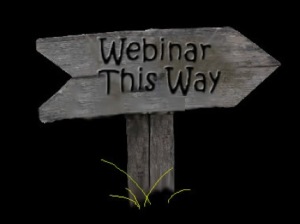Lessons from Iyanla Vanzant: How to Fix Your Life after Adversity

Compared to other types of content formats such as blog posts or white papers, webinars are the most immersive. They allow attendees to interact with the content, the speaker and other participants in a way that other forms of content don’t.
Today, up to 62% of marketers incorporate webinars into their content marketing and lead generation strategy. Webinars are the third most effective content marketing channel for various reasons:
Most importantly, marketers are using webinars as a content delivery channel for lead generation, nurturing and sales conversions- all inbound activities.
Here are some best practices for leveraging the power of webinars to maximize your inbound marketing efforts:
Webinars are necessary throughout the sales funnel. Marketers often assume that webinars would only work great for lower funnel lead generation activities such as product demos. However, webinars can also be used to nurture top funnel prospect to the bottom of the funnel.
Effective webinars, like other content forms, should be mapped to the funnel stage of the target audience. New prospects will require a different content presentation compared to middle or bottom funnel audiences.
 While top funnel prospects could be more receptive to a webinar introducing them to the company’s products and services, middle funnel prospects would require different content such as a product tour or an interactive Q & A session.
While top funnel prospects could be more receptive to a webinar introducing them to the company’s products and services, middle funnel prospects would require different content such as a product tour or an interactive Q & A session.
A good way to map content to customers’ buying journey is to ask what type of information the prospect needs before they can make a purchasing decision.
A webinar is a powerhouse of content. This means that a single webinar can be reused and repurposed into different content formats that offer more opportunities for inbound lead generation and conversion.
Repurpose your webinars into a series of blog posts, ebook, tweets, white papers, shorter videos for lead generation and nurture campaigns, embed the webinar recording on YouTube and SlideShare, or offer access to the recording for a limited time and then gate the content.
The more content formats you break down your webinar into, the more opportunities you create for organic traffic generation, list building and sales.
Overall, reusing your webinars allows you to fill up your content distributing channel without requiring an extra budget for content creation.
The success of a webinar solely hinges on your promotion efforts. The more you market and promote your event, the greater the audience reach. In turn, you will have a wider leads base for your conversion efforts.
Here’s what to consider to maximize your promotion efforts:
Your landing page is the most essential aspect of your promotion matrix. A professionally built landing page must include:
A webinar is successful as an inbound marketing tool to the extent that it generates a sufficiently large audience.
Collaborating with influencers allows you to piggy-back on their already established audience and thought leadership.
Influencers also lend credibility, allowing you to extend your reach to a wider audience.
Reaching out to niche influencers requires a strategic plan for you to actually get them on board, but the efforts are certainly worthwhile if your goal is to reach out to as wide an audience as possible.
Sharing your influencer’s content, reading and commenting on their blog, attending their own webinars and events, are examples of paths you can take as part of your influencer marketing strategy.
For just a small investment, webinars can offer greater returns in terms of traffic generation, brand awareness, lead generation, thought leadership and sales. Strategic partnerships with influencers and extensive promotion are at the heart of successfully using webinars to bolster your inbound campaigns.
When you visit any web site, it may store or retrieve information on your browser, mostly in the form of cookies. Control your personal Cookie Services here.